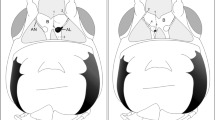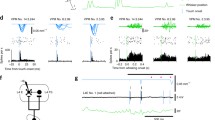Summary
-
1.
A glass microelectrode was used to stimulate plurisegmental fibres in the locust ventral nerve cord. Simultaneous intracellular recording from neck muscle motoneurons (to muscles 54 and 56) and some leg motoneurons in the prothoracic ganglion allowed testing of the connections of these fibres to the motoneurons.
-
2.
Single pulse stimulation at many positions in the connective evoked both an epsp followed by an ipsp in the same motoneuron. In most cases the epsp was produced via monosynaptic connections (latency and high frequency stimulation tests) but sometimes a spiking or nonspiking interneuron was interposed. In one case a fast ipsp was followed by an epsp (Figs. 7–9). The effects attributable to each stimulating pulse were termed direct effects.
-
3.
When the stimulation was applied as short trains (30–100 Hz for 200 ms) the direct epsp's added to produce excitation during the train; the ipsp's added to produce inhibition for up to 1 s after the train (Figs. 7, 8, 10 and 11). These direct effects may influence the timing of motor outputs.
-
4.
Certain stimulating positions evoked not only direct effects but also quite different long lasting motor aftereffects; the responsible fibres were classified separately as ‘activating’ interneurons. They could be multimodal but, like the other plurisegmental fibres studied here, were predominantly mechanosensory and some responded to movement (Figs. 2–6).
-
5.
Unlike the direct effects, the long lasting motor aftereffects could not be related to each stimulus pulse. They were often larger in amplitude than the direct effects and consisted of barrages of mixed excitation and inhibition, lasting several seconds after a 200 ms stimulus and dramatically altering the motor excitation state of the whole body. The effects varied in form with the stimulating site, ranging from regular to quite unpatterned (Figs. 4, 13, 14 and 17).
-
6.
Intracellular recordings and experiments where the ganglion was isolated showed that the long lasting aftereffects were generated locally. The ‘activating’ interneurons initiate long lasting activity in locally active interneurons which in turn drive the motoneurons and produce the major part of the motor effects (Figs. 15 and 16).
-
7.
While the direct effect psp's added with the epsp's from a monosynaptic sensory-motor pathway, the sensory epsps's were enhanced or diminished during the aftereffects. Thus, sensory inflow to motoneurons can be gated by local interneurons under the control of ‘activating’ fibres (Figs. 12 and 18).
-
8.
‘Activating’ fibres may play a significant role in selecting thoracic motor programmes and setting motor excitation using local interneurons as an interface. Their direct effects and those of the other plurisegmental interneurons described here may contribute to timing of motor outputs.
Similar content being viewed by others
References
Aréchiga, H., Wiersma, C.A.G.: The effect of motor activity on the reactivity of single visual units in the crayfish. J. Neurobiol.1, 53–70 (1969)
Bacon, J., Tyrer, N.M.: The tritocerebral commissure giant neuron (TCG): a bimodal interneuron in the locustSchistocerca gregaria. J. Comp. Physiol.126, 317–325 (1978)
Bentley, D.: Control of cricket song patterns by descending interneurons. J. Comp. Physiol.116, 19–38 (1977)
Burrows, M.: Modes of activation of motoneurons controlling ventilatory movements of the locust abdomen. Philos. Trans. R. Soc. (London) Ser. B269, 29–49 (1974)
Burrows, M.: Graded synaptic interactions between local premotor interneurons of the locust. J. Neurophysiol.42, 1108–1123 (1979)
Burrows, M.: The control of sets of motoneurones by local interneurons in the locust. J. Physiol. (London)298, 213–233 (1980)
Burrows, M., Rowell, C.H.F.: Connections between descending visual interneurons and metathoracic motoneurons in the locust. J. Comp. Physiol.85, 221–234 (1973)
Eibl, E.: Morphology of the sense organs of the proximal parts of the tibiae ofGryllus campestris L. andGryllus bimaculatus de Geer (Insecta, Ensifera). Zoomorphologie89, 185–205 (1978)
Elsner, N.: Kommandofasern im Zentralnervensystem der HeuschreckeGastrimargus africanus (Oedipodinae). Zool. Anz. (Suppl.)33, 465–471 (1969)
Graubard, K., Calvin, W.: The neuron doctrine re-examined: implications of spikeless synaptic transmission and dendritic geometry. In: The Neurosciences, Fourth Study Program. Schmitt, F.O., Worden, F.G. (eds.). Cambridge, Mass.: MIT Press 1979
Grillner, S.: Command neurons or central program controlling system? Behav. Brain Sci.1, 23–24 (1978)
Hustert, R.: Segmental and interganglionic projections from primary fibres of insect mechanoreceptors. Cell Tissue Res.194, 337–351 (1978)
Kater, S.B., Fountain, R.L., Hadley, R.D.: Reversible procaine block of activity in selected nerve trunks. J. Electrophysiol. Techniques5, 30–35 (1976)
Kennedy, D., Davis, W.: Organization of invertebrate motor systems. In: Handbook of physiology, Sect. I: The nervous system, Vol. I. Cellular biology of neurons, Part 2. Brookhart, J.M., Mountcastle, V.B. (eds.), pp. 1023–1087. Bethesda, Maryland: Am. Physiol. Soc. 1977
Kien, J.: Variability of locust motoneuron responses to sensory stimulation: A possible substrate for motor flexibility. J. Comp. Physiol.134, 55–68 (1979)
Kien, J.: Morphology of locust neck muscle motoneurons and some of their inputs. J. Comp. Physiol.140, 321–336 (1980)
Kien, J., Altman, J.S.: Connections of the locust wing tegulae to metathoracic flight motoneurons. J. Comp. Physiol.133, 299–310 (1979)
Kuno, M., Miyahara, J.T.: Non-linear summation of unit synaptic potentials in spinal motoneurones of the cat. J. Physiol. (London)201, 465–477 (1969)
Kupfermann, I., Weiss, K.R.: The command neuron concept. Behav. Brain Sci.1, 1–10 (1978)
Larimer, J.L.: Command interneurons and locomotor behavior in crustaceans. Adv. Behav. Biol.18, 293–325 (1975)
Otto, D.: Untersuchung zur nervösen Kontrolle des Grillengesanges. Zool. Anz. (Suppl.)31, 585–592 (1967)
Pearson, K.G., Wong, R.K.S., Fourtner, C.R.: Connections between hair-plate afferents and motoneurones in the cockroach leg. J. Exp. Biol.64, 251–266 (1976)
Rowell, C.H.F.: Incremental and decremental processes in the insect central nervous system. In: Short-term changes in neural activity and behaviour. Horn, G., Hinde, R.A. (eds.), pp. 237–280. Cambridge University Press 1970
Shepheard, P.: Musculature and innervation of the neck muscles of the desert locust (Schistocerca gregaria Forskal). J. Morphol.139, 439–464 (1973)
Tyrer, N.M., Altman, J.S.: Motor and sensory flight neurones in a locust demonstrated using cobalt chloride. J. Comp. Neurol.157, 117–138 (1974)
Tyrer, N.M., Bacon, J., Davies, C.A.: Primary sensory projections from the wind sensitive head hairs of the locustSchistocerca gregaria. Cell Tissue Res.202, 79–92 (1979)
Usherwood, P.N.R., Grundfest, H.: Peripheral inhibition in skeletal muscle of insects. J. Neurophysiol.28, 497–518 (1965)
Wilson, D.M., Wyman, J.R.: Motor output patterns during random and rhythmic stimulation of locust thoracic ganglia. J. Comp. Physiol.5, 121–143 (1965)
Wine, J.J.: Crayfish escape behavior. II. Command-derived inhibition of abdominal extension. J. Comp. Physiol.121, 173–186 (1977)
Author information
Authors and Affiliations
Additional information
This work was supported by DFG Grants Hu 35/17 and Hu 35/18. F. Herrmann and R. Zanninelli provided technical assistance. Discussions about these experiments with the late Dr. Sheldon Zack were both extremely helpful and a great pleasure. His loss is deeply mourned.
Rights and permissions
About this article
Cite this article
Kien, J. Mechanisms of motor control by plurisegmental interneurons in locusts. J. Comp. Physiol. 140, 303–320 (1980). https://doi.org/10.1007/BF00606271
Accepted:
Issue Date:
DOI: https://doi.org/10.1007/BF00606271




